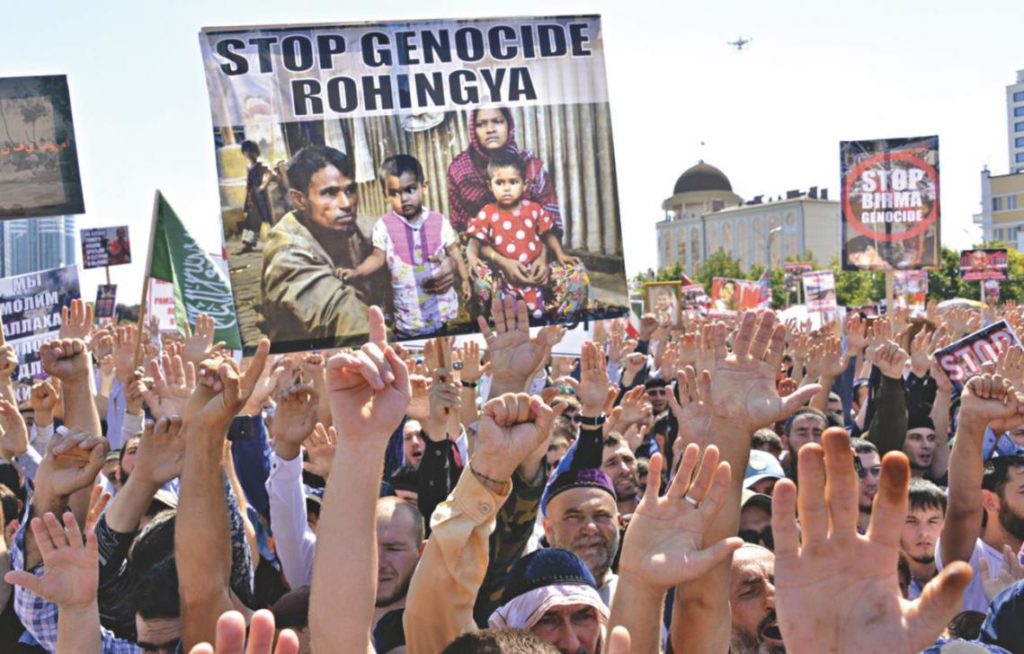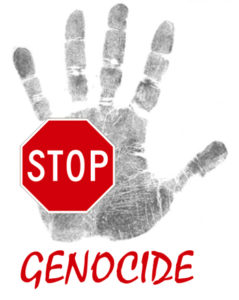Burma/Myanmar: Call It Genocide
ASIA--PACIFIC, 27 Nov 2017
Gregory Stanton – The Daily Star
The UN calls the Myanmar army’s aggression against the Rohingya “ethnic cleansing”. “Ethnic cleansing” is a term invented by Slobodan Milosevic. It’s a euphemism for forced displacement and genocide. It’s an insidious term because there is no international treaty law against it, whereas there are international laws against forced displacement and genocide.

People take part in a rally in support of Myanmar’s stateless Rohingya minority in the Chechen capital of Grozny, Russia,on September 4, 2017.
PHOTO: Reuters
20 Nov 2017 – “Ethnic cleansing” is not a crime under the Rome Statute of the International Criminal Court. It has no legal meaning in international law. Another term without legal meaning is “atrocities”.
Genocidal massacres are acts of genocide. Genocide is defined as acts intended to destroy, in whole or in part, a national, ethnic, racial, or religious group. They include killing, causing serious bodily or mental harm, and inflicting conditions of life on a group calculated to bring about its physical destruction, in whole or in part.
Over 600,000 Rohingya have fled into Bangladesh in the past three months to escape systematic massacres by the Myanmar army that has slaughtered thousands of Rohingya and burned over 500 Rohingya villages to the ground. The killings continue today.
 Genocidal massacres are precisely what the Myanmar army and Rakhine militias are committing against the Rohingya. Myanmar is committing both “ethnic cleansing” [forced displacement] and genocide. The crimes often go together. Genocidal massacres are used to terrorise a victim group into fleeing.
Genocidal massacres are precisely what the Myanmar army and Rakhine militias are committing against the Rohingya. Myanmar is committing both “ethnic cleansing” [forced displacement] and genocide. The crimes often go together. Genocidal massacres are used to terrorise a victim group into fleeing.
Why does the so-called “international community” avoid using the word “genocide”?
Many people think “genocide” requires millions of deaths. Thousands aren’t enough. But the Genocide Convention outlaws intentional destruction “in part” of ethnic or religious groups.
Lawyers have gutted the word “genocide” by insisting on proof of “specific” intent beyond a reasonable doubt. Some even claim that only a court can invoke the word “genocide”.
This view is profoundly wrong. It ignores the very name of the International Convention for the Prevention and Punishment of the Crime of Genocide. Courts judge genocide after it’s over—when it’s too late for prevention.
Myanmar’s systematic campaign of mass murder and destruction is surely enough proof of specific intent to destroy part of the Rohingya people.
Those who ignore the power of words argue that “ethnic cleansing”, “crimes against humanity” or “atrocities” are just as terrible as genocide.
They’re wrong. “Genocide” is a much more powerful word.
Three epidemiologists and I studied the impact of using the words “ethnic cleansing” rather than “genocide” in four genocides: Rwanda, Bosnia, Kosovo, and Darfur. We counted the number of times “ethnic cleansing” and “genocide” were used in The New York Times, UN statements, major law journals, and reports by Amnesty International and Human Rights Watch.
Our study concluded:
- Use of the terms has no relationship to the number of people killed. Eight thousand killed at Srebrenica was ruled “genocide” by the International Criminal Tribunal for the former Yugoslavia. Yet a UN Commission of Inquiry held that over 50,000 killed in Darfur (now over 300,000) was a “crime against humanity” but not genocide.
- The term chosen is determined by the willingness to take forceful action to stop the killing.
- It was not until “genocide” became the dominant term, that force was used to stop it.
This tipping point occurred three months into the genocide in Rwanda. The US State Department finally admitted on June 10, 1994 that “acts of genocide” in Rwanda are the same as “genocide”. But recognition of “genocide” came too late.
Eight hundred thousand Rwandans were already dead.
The same denial emerged in Bosnia. The UN and press called the massacres “ethnic cleansing” from 1992 until the Srebrenica massacre in July 1995. A NATO meeting on July 21 called it “genocide”. NATO bombing of Serb forces followed on August 30. Milosevic agreed to a ceasefire, division of Bosnia, and NATO peacekeeping. The Bosnian genocide stopped.
Kosovo was called “ethnic cleansing” until US Ambassador David Scheffer noted “indicators of genocide” on April 7, 1999. Bombing of Belgrade followed immediately, with Serb surrender and NATO occupation of Kosovo.
Darfur is the exception that proves the rule. The UN refused to invoke the G word: “genocide”. No military forces were sent to stop the crimes. Instead the African Union and UN sent “monitors” to observe them. The Darfur genocide continues to this day.
The UN avoids the word “genocide” because world leaders avoid military action to stop it.
Genocide is not a sacred or magic word. But when the word “genocide” is used, force to stop it becomes possible. Weaker words like ethnic cleansing, crimes against humanity, or atrocities mean that no force will be used to stop the massacres.
Will the UN send troops to protect the Rohingya when they are forced to return to Myanmar? Not if the UN denies that Myanmar is committing genocide against the Rohingya. World leaders will again fail to stop the Crime of Crimes.
____________________________________
Gregory Stanton is the Founding Chairman of Genocide Watch. http://www.genocidewatch.com
Go to Original – thedailystar.net
DISCLAIMER: The statements, views and opinions expressed in pieces republished here are solely those of the authors and do not necessarily represent those of TMS. In accordance with title 17 U.S.C. section 107, this material is distributed without profit to those who have expressed a prior interest in receiving the included information for research and educational purposes. TMS has no affiliation whatsoever with the originator of this article nor is TMS endorsed or sponsored by the originator. “GO TO ORIGINAL” links are provided as a convenience to our readers and allow for verification of authenticity. However, as originating pages are often updated by their originating host sites, the versions posted may not match the versions our readers view when clicking the “GO TO ORIGINAL” links. This site contains copyrighted material the use of which has not always been specifically authorized by the copyright owner. We are making such material available in our efforts to advance understanding of environmental, political, human rights, economic, democracy, scientific, and social justice issues, etc. We believe this constitutes a ‘fair use’ of any such copyrighted material as provided for in section 107 of the US Copyright Law. In accordance with Title 17 U.S.C. Section 107, the material on this site is distributed without profit to those who have expressed a prior interest in receiving the included information for research and educational purposes. For more information go to: http://www.law.cornell.edu/uscode/17/107.shtml. If you wish to use copyrighted material from this site for purposes of your own that go beyond ‘fair use’, you must obtain permission from the copyright owner.